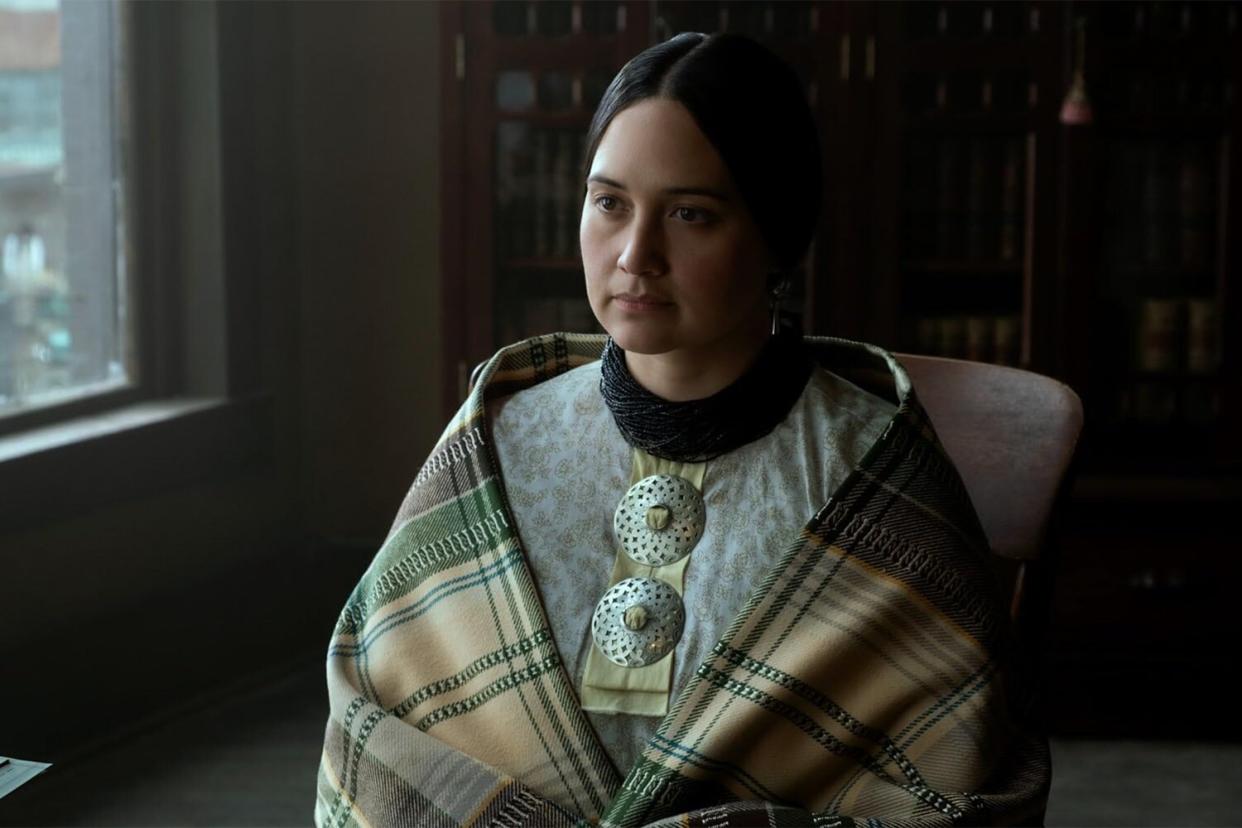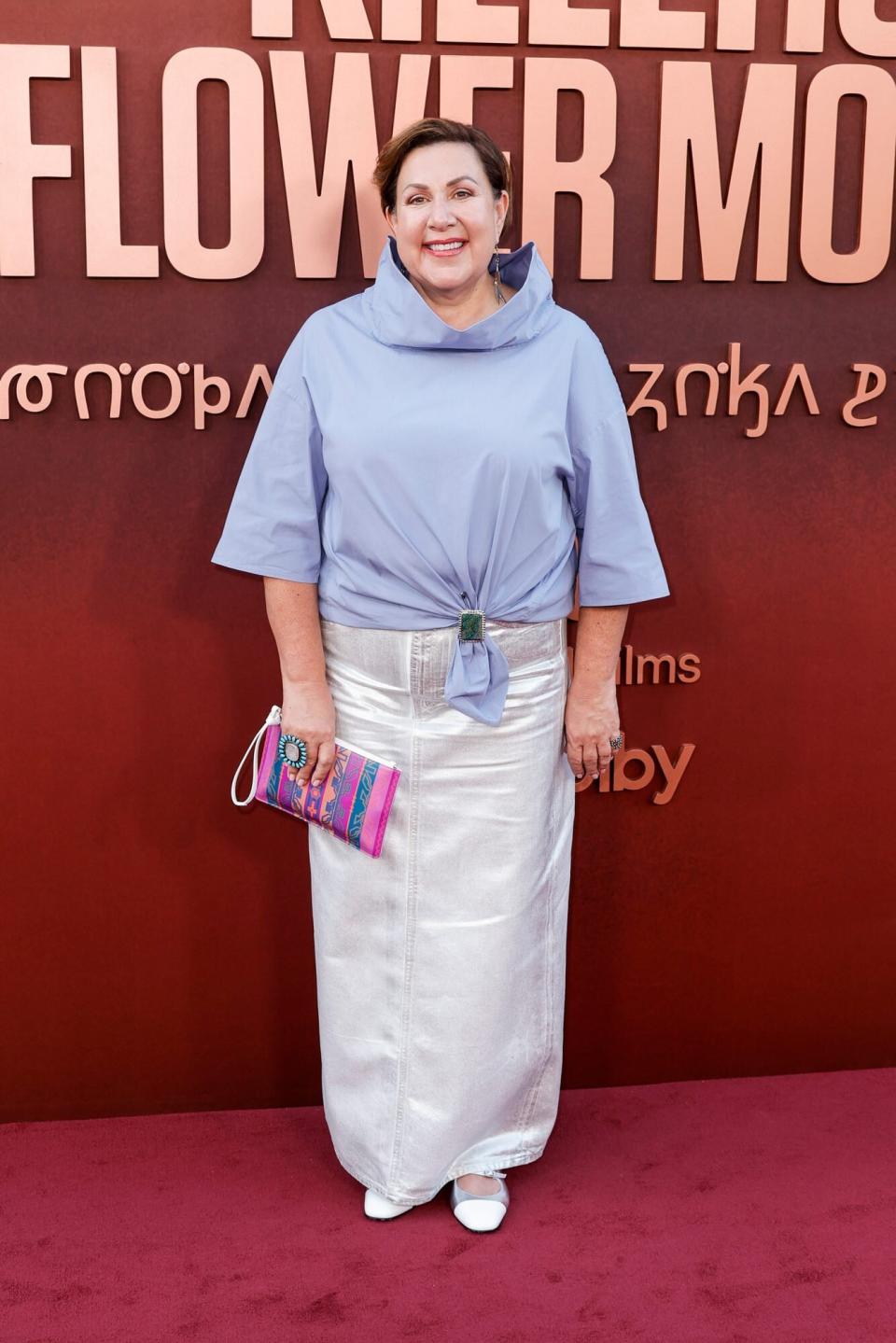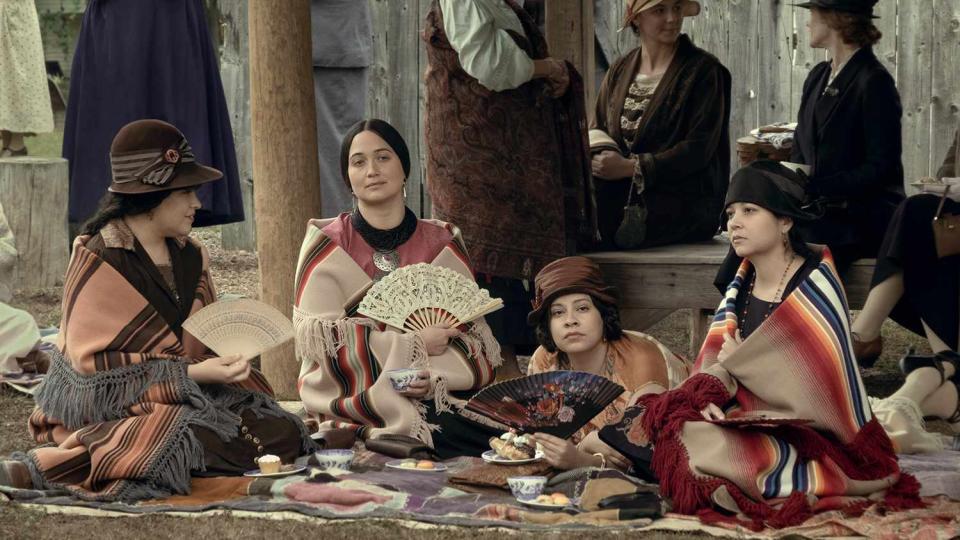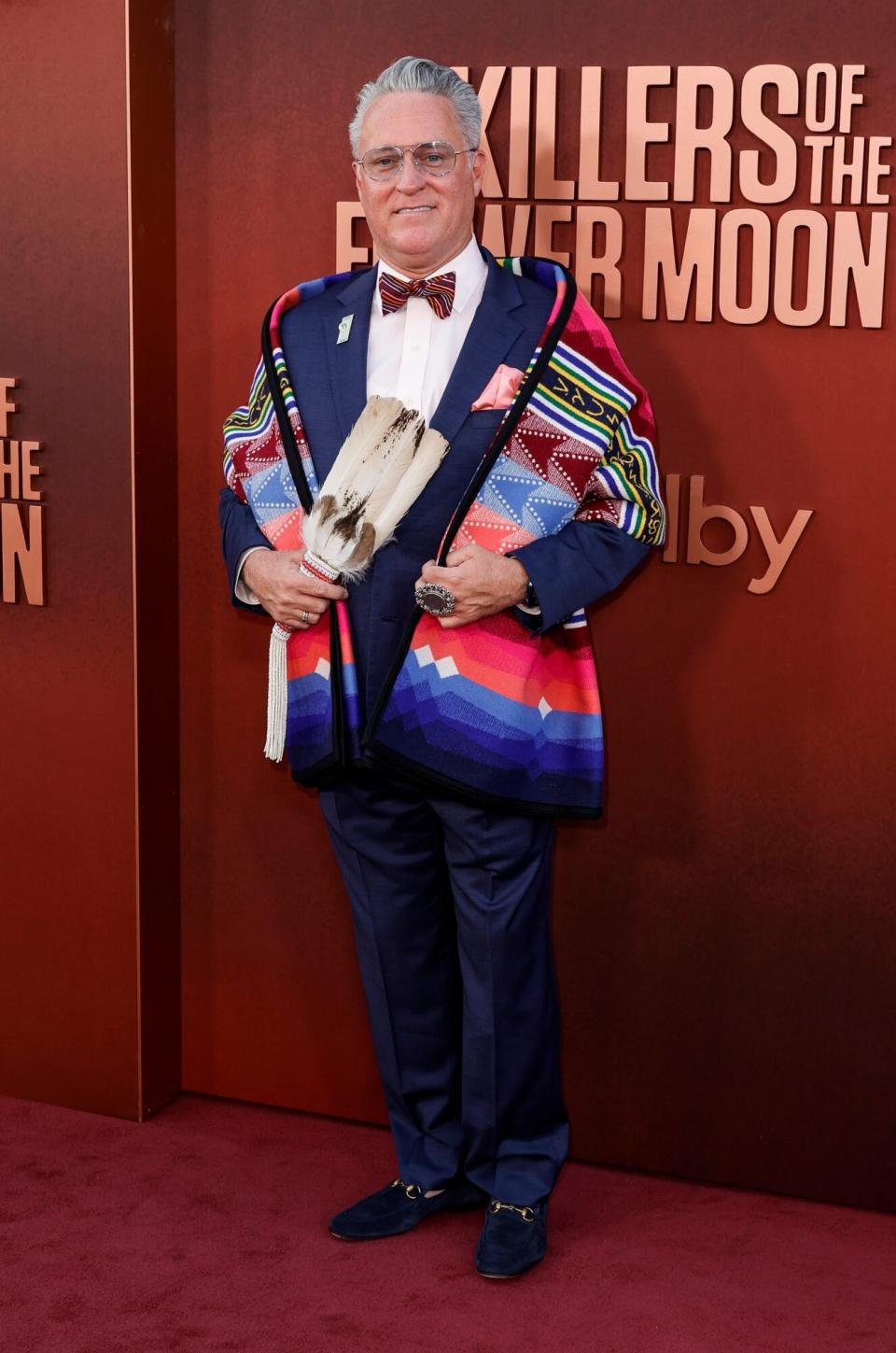How Osage influence brought “Killers of the Flower Moon ”to life

Julie O'Keefe remembers the first time she saw Killers of the Flower Moon. A native of Pawhuska, Okla., O'Keefe worked as costume consultant on Martin Scorsese's epic crime drama, which tells the story of how white people targeted and brutally murdered wealthy Osage people in 1920s Oklahoma. Late last year, she joined key Osage Nation members and consultants — including Osage Nation Chief Geoffrey Standing Bear, the late consultant John Williams, and consulting producer and ambassador Chad Renfro — for an early screening. At the time, the film was still unfinished with temporary effects and music. But even though she's since seen it seven times, it's that early viewing that still sticks with her.
"I had so many feelings," she remembers. "From, 'Oh my God, this is my people and my story, and it's being heard,' to 'Look at that blanket! I remember putting it on that day when it was 107 [degrees].' But it was really about getting to sit down and see the beauty and the tragedy and the horror of the script."
O'Keefe is among the countless Osage experts and crew members who worked on Killers of the Flower Moon, stretching across multiple years and departments. Based on David Grann's best-selling book, the film chronicles how, after the Osage discovered oil deposits on their land, a group of white men plotted to murder them and steal their newfound wealth. Robert De Niro and Leonardo DiCaprio play William "King" Hale and Ernest Burkhart, a white uncle and nephew who helped orchestrate many of the murders, while Lily Gladstone stars as Ernest's Osage wife Mollie.

Apple TV+ Lily Gladstone in 'Killers of the Flower Moon'
The Osage murders are a brutal and often overlooked chapter in American history, and many members of the Osage Nation admit that when they first heard Grann had sold the film rights to his 2017 book, they were concerned by how Hollywood might depict their story on screen. In early drafts, the script hewed close to Grann's book, focusing primarily on the early days of the FBI and the investigators who helped uncover the killings. But Scorsese and writer Eric Roth later overhauled the script, shifting the film's perspective away from the FBI and toward Ernest and Mollie. That was when DiCaprio switched parts, moving from the role of FBI agent Tom White (played in the film by Jesse Plemons) to Ernest Burkhart.
"I can say that we were very concerned," Chief Standing Bear told reporters at a press conference last month. "I can also tell you that when Marty showed up in my office, he started out right off saying, 'We're going to film here. We're going to tell this story through the eyes of Mollie.' And it was a process of building trust like David [Grann] did."
Hollywood has a dismal history of accurately depicting Indigenous stories, and early in the production, about six years ago, Renfro reached out to the production team, inviting them to meet with the Osage Nation. He was among those who were apprehensive, and he pushed hard for the production to shoot on location in Oklahoma. An interior designer by trade, he had no experience in film production. But he soon took on a job as the tribe's ambassador for the film, serving as a consulting producer.
"The first few years, I was working on this pro bono alongside my interior design career," Renfro tells EW. "It may seem obvious to some, but I thought that it was so important for them to film where this blood was shed, where these things happened in Gray Horse, Pawhuska, and Fairfax."

Apple TV+ Lily Gladstone and Leonardo DiCaprio in 'Killers of the Flower Moon'
The result is a film with an unprecedented number of Indigenous cast and crew, and Renfro worked to connect external crew members with Osage experts in language, history, and more. O'Keefe was one of those experts, with a deep knowledge of Osage clothing and tradition. She had previously worked in the museum world and as a furniture designer, and she collaborated with costume designer Jacqueline West to help maintain the film's accuracy. She remembers her first day walking into West's studio, where the designer had covered every inch of the walls in historical reference photos, specifically from the 1920s. "I was like, 'Wow, she really gets us,'" O'Keefe remembers. "She is really working on this authentic piece, and it shows. I could tell right then that we were going to get on famously."
O'Keefe adds that as helpful as photographs can be, there's nothing like the real thing. One of the benefits of shooting on Osage land and in the Osage community was the wealth of stories and firsthand reference points. Early on in the production process, O'Keefe and West organized a community trunk show, renting an airport hangar in nearby Bartlesville and inviting members of the community to come show off their family heirlooms. Those items were photographed and then replicated or used for inspiration.
"The community was so involved in making sure that the story was authentic," O'Keefe explains. "It really encompassed bringing in the community and giving them a voice and letting them share, which is not something that we typically do. Nobody knows what's in my chest, and we don't go around showing each other. So, it's a big deal for someone to take priceless family possessions and drive it out to an airport hangar and show you what they have."
"It was like having little mini museums rolling up," she remembers. "They would open up these little treasure boxes, and out would come all these gorgeous old items: old shawls, old blankets that you can't get any longer, some from companies you've never heard of."

Apple TV+ The wedding coats in 'Killers of the Flower Moon'
One of the costumes that means the most to O'Keefe and West is the traditional wedding coat that Mollie wears for her wedding to Ernest. Wedding coats have a long history in Osage tradition, and there are about six in the final film. O'Keefe explains that it's a tradition that dates back to Thomas Jefferson: In the early 1800s, a group of Osage delegates traveled to meet with the U.S. president. The chief delegate admired one of the U.S. soldiers' military coats, so it was given to him as a gift. O'Keefe notes that Osage men tend to be over 6 feet tall and "huge, strapping men with big, broad shoulders," so the coat didn't fit him. Instead, the man gave it to his daughter, kickstarting a tradition that endured for decades.
"If you were marrying someone who had a military coat, you knew that you were marrying someone of great importance in the tribe," O'Keefe explains. "There was somebody in your family that had gone to one of those meetings. Years later, when you have the government coming in to try to show you their force, it was a way to take something that is militant and forceful and turn it into a thing of beauty."
"One thing I often say is that forces have always come in to try to control us as Osages and as a Native people," she adds, "but my Osage people have always been able to take that control and turn and make it work for them. That wedding coat, to me, is a perfect example of that."

Frazer Harrison/Getty Julie O'Keefe at the Los Angeles premiere of 'Killers of the Flower Moon'
Killers of the Flower Moon also assembled a huge ensemble cast, recruiting many first-time actors from the Osage Nation. In all, the film has 63 credited and named Indigenous roles. Of those, all but 14 are played by Osage actors. (The others are members of other Indigenous communities.) For casting, Scorsese tapped his longtime collaborator Ellen Lewis, who's worked with him on nearly every one of his films, stretching back to 1990's Goodfellas. Lewis teamed up with fellow casting director Rene Haynes, whom she had worked with on the Netflix miniseries Godless and who has built her career working with Native actors.
In late 2019, the pair launched a massive open casting call in Oklahoma. Between Pawhuska, Oklahoma City, and Tulsa, they estimate they saw more than 2,500 people. Some later roles were cast via Zoom, especially after the pandemic began in early 2020, but Lewis says that early in-person casting call was vital.
"When we were in Pawhuska for our first three days, so many people from the Osage Nation came," Lewis explains. "And so many people had stories or family members who were affected by this story."
In many cases, working on Killers of the Flower Moon was a family affair. While O'Keefe was working as a costume consultant, for example, her son appeared as a background actor. Haynes and Lewis note that they discovered some actors only after a family recommendation. One such example was Everett Waller, who plays Osage leader Paul Red Eagle in the film. Waller didn't initially attend the open casting call, but his daughter did. When Haynes mentioned that they specifically needed older male actors with long hair, his daughter replied, "Oh, my dad has long hair!"
"I said, 'Will you go get him?'" Haynes remembers with a laugh. "She said he was kind of busy, and I said, 'Tell him that if you bring him back, he can skip the line and just talk to me for a few minutes.' So, he came back, and he didn't know why we wanted him there. He thought he was coming back to help his daughter. But he's just a marvelous presence in the film."

Apple TV+ JaNae Collins, Lily Gladstone, Cara Jade Myers, and Jillian Dion in 'Killers of the Flower Moon'
Haynes has cast Indigenous actors in dozens of films and TV shows, but she notes that she particularly loved getting to cast so many female roles. Legendary actress Tantoo Cardinal, who is of Cree and Métis heritage, plays Mollie's mother Lizzie Q, while Cara Jade Myers, JaNae Collins, and Jillian Dion play Mollie's three sisters.
"I knew many eyes were going to be on this project and on this cast," Haynes adds. "It was also primarily female Indigenous actors, and that is rare. I mean, I've done a few [projects] where there were female protagonists, but the majority of the roles are still men. This was creating a family of women, and that was very special."
"Marty knew and loved Tantoo from her work in Black Robe, and we were very lucky to have her in the film as the mother," Lewis explains. "Her presence is almost indescribable as the matriarch of these four sisters. And what a blessing for us to build a family of women in a movie like this."
Some have criticized Killers of the Flower Moon for centering its story on white men like Ernest Burkhart and William Hale. Osage language consultant Christopher Cote, who worked on the film, recently made headlines at a Killers red carpet event, where he told The Hollywood Reporter that Scorsese "did a great job," but the film wasn't "made for an Osage audience," and he wished the story centered more on Mollie's perspective.
"As an Osage, I really wanted this to be from the perspective of Mollie and what her family experienced, but I think it would take an Osage to do that," Cote told THR. "Martin Scorsese, not being Osage, I think he did a great job representing our people, but this history is being told almost from the perspective of Ernest Burkhart and they kind of give him this conscience and kind of depict that there's love. But when somebody conspires to murder your entire family, that's not love. That's not love, that's just beyond abuse."

Frazer Harrison/Getty Chad Renfro at the Los Angeles premiere of 'Killers of the Flower Moon'
Renfro is the first to admit that Killers is not a complete depiction of the Osage experience, even with a runtime of three-and-a-half hours. "The movie doesn't delve into all of our culture and our traditions," he says. "It's only given a certain amount of time, but it's given deference. I would say it's as accurate as possible." Besides, the film only covers a very specific (and very brutal) part of the Osage history. Still, he and his collaborators fought to keep the film as authentic as possible — from the costumes and locations used to the language spoken.
"Marty always says he set out to make a film about trust and betrayal," Renfro explains. "Every step of the way, all the way through, they were continuing to develop trust within our community. We all developed a sense of family together, and I don't know that that happens on every film."
"That's part of the main reason why I felt like they needed to make it here because that's who we are," he adds. "We're very generous. We're very giving. We're also very trusting, even after all these years of having our trust betrayed. But I can tell you that if that trust had been violated or betrayed anywhere along the way in this process, the full force of the Osage Nation would have reversed course. If there was the slightest sense of betrayal or someone not doing what they said they were going to do and it wasn't corrected immediately, it would have come to a halt."
"It's an epic film that felt like a community project," O'Keefe adds.
Ultimately, Renfro hopes that Killers is only a first step. Ideally, he says, it will set a precedent for Indigenous representation in future films — both behind and in front of the camera.
"We're 25,000 members," he says. "Our language was nearly extinct, and here it is being spoken on the big screen. Here we are being taken seriously in a new way. There are so many different opinions about how it could be done differently, but I think we need to focus on how it was done — and how it can be done better the next time. We want to build off this huge platform, rather than pick this platform apart."
"We may have missed the mark here or there, but we hit the mark out of the ballpark in so many ways," he adds. "Let's take that momentum and really move forward with it. I really challenge filmmakers and Hollywood to take that to heart."
Want more movie news? Sign up for Entertainment Weekly's free newsletter to get the latest trailers, celebrity interviews, film reviews, and more.
Related content:
Martin Scorsese rewrote Killers of the Flower Moon so it wasn't just 'about all the white guys'
Leonardo DiCaprio's improv annoyed Robert De Niro and Martin Scorsese in Killers of the Flower Moon
Osage consultants weigh in on the complex feelings of watching Killers of the Flower Moon
Killers of the Flower Moon is a brilliant synthesis of Martin Scorsese's filmography


